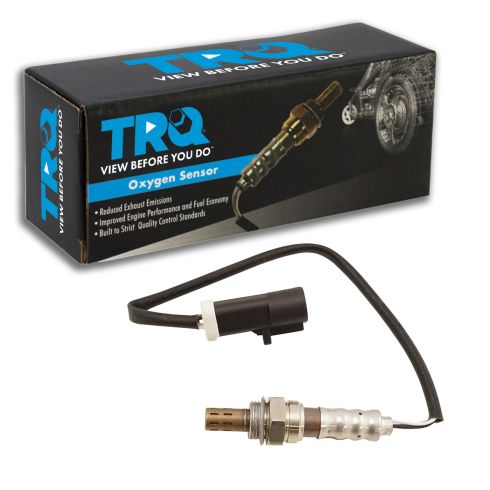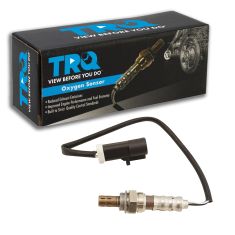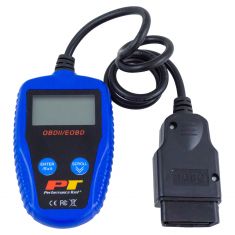1AEOS01021-O2 Oxygen Sensor TRQ OSA61313

Replaces
2006 Ford E150 V8 5.4L Upstream Left Bank 2 Sensor 1 O2 Oxygen Sensor TRQ OSA61313

Frequently bought together
Product Reviews
Loading reviews
4.93/ 5.0
15
15 reviews
Awesome product
May 3, 2018
Recieved this item perfect fit recieved item quickly I have previous items from this company for my 05 navigator and each item perfect fit I will continue to order, from this company
02 sensor
August 20, 2018
been in the auto motive field for years and found quality products for my friends and family and great videos as well .prices are really great ... thanks .
MY REVIEW
October 1, 2018
Great product and fit perfectly! I couldnt be happier.
Awesome Service
June 22, 2019
02 sensor for my 1996 Ford F-150 part fit with no problems. Mechanic installed service light went off. Would recommend product. Part has a warranty with free shipping.
Perfect part, Perfect fit
July 20, 2019
The part was the perfect fit and resolved my o2 sensor warning. The only thing you should consider is how old and how much mileage you have on the vehicle. My truck is 18 years old and has 150K miles. I needed the o2 open ratchet with a short breaker bar to get mine out. The exhaust support bracked made getting to the sensor a little tricky
September 26, 2019
Well worth the money. Fit first time.. check engine light went out. Passed inspection no problem
High Quality O2 Sensor
October 8, 2019
This O2 sensor worked with no problem. Plug and play and the computer recognized the new part with no issues. I liked the fact that the threads already had the correct anti-seize already applied to the threads.
Oxygen sensor
August 13, 2020
The part was the right and identical part for my ranger fit perfect and hooked up just like original only problem took about 8 days to arrive instead of 3 but I believe that was because of the covid 19 I would highly recommend 1aauto auto parts to everyone great parts an great price thanks gw
Easy to follow video tutorial made for easy installation
August 27, 2020
The guys at 1A Auto are always thorough with their explanations and make it easy for somebody to follow along with their own DIY repairs.
Fast,cheap, good quality,in a secure package ..
January 7, 2021
For people who's thinking in the o2 sensor its just for emission porpuse... !!!NO.. you really notice your auto its running better.. and that better its thanks to 1a Auto
5 STARS
August 2, 2021
I love 1aauto. GREAT PRICE AND PERFECT FIT.
Perfect fit! Great product.
December 9, 2021
Fit perfectly in my 93 1.9l Ford Escort.
Great part for most part:)
January 19, 2023
Easy install and fixed my code and lean issue. But doent have short term fuel trim sensor built in like oem so the cars computer tries to guess injector adjustments and matches the idle weird sometimes
Runs better
[{"url": "https://wac.edgecastcdn.net/001A39/prod/media/pNISJll75W64CYGsite/ef96773df742900107d965ad19a83532_1701516972747_0.jpeg", "caption": ""}]
December 2, 2023
Better gas mileage
June 6, 2024
Worked perfectly. Easy install.
Customer Q&A
is the down stream sensor also called a return sensor?
January 18, 2019
10
Normally they are called just down stream sensors.
January 19, 2019
Corey M
Is this going to fit both the driver and the passenger side?
February 13, 2019
10
This part will fit in both the Upstream and Downstream positions depending on the vehicle. We will need more information about your vehicle to confirm the fit.
February 13, 2019
Christa R
Is that part for 2010 escape with v6 ?
June 6, 2019
10
Yes, according to the information you provided, this part will fit your vehicle.
June 6, 2019
Emma F
on 2010 f150 wich is 02 sensor bank 1 sensor 1 ?
February 12, 2021
10
You would have to check with a local mechanic or your dealer. Sensor one is always upstream, but the banks will change from vehicle to vehicle.
February 12, 2021
Adam G
on a 2009 f150 5.4 V8, will this 02 sensor fit both upstream and downstream on both sides?
March 16, 2021
10
This part will only replace the downstream sensors on your vehicle.
March 16, 2021
Andra M
What does the L4 in "2004 Ford Ranger L4 2.3L Downstream O2 Oxygen Sensor" refer to?
June 30, 2021
10
That refers to the style of engine, so inline (L) 4 cylinder (4) engine. 2.3L is the displacement in liters, so this is for a 2.3 liter 4 cylinder inline engine.
June 30, 2021
T I
Ford is a registered trademark of Ford Motor Company. 1A Auto is not affiliated with or sponsored by Ford or Ford Motor Company.
See all trademarks.
























